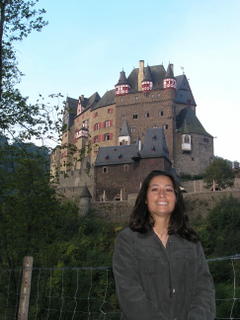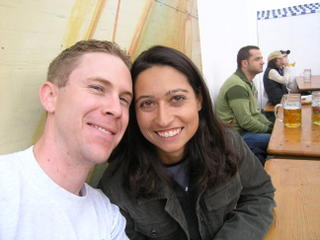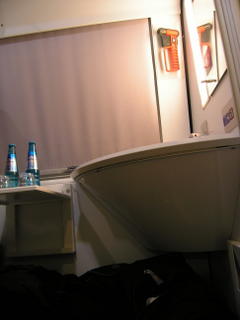No Bull
We're home now, but I can't sleep anymore.
Part of Saturday in Madrid was spent at the bull fighting stadium, Plaza de Toros. Performing in the Madrid arena, for the Matadores, is the grandest stage that can be achieved in Europe we were told by an afficienado (fan) we met on the plane home. Most of the information about ceremony and why things happened are based off of the conversation Jennie and I had with the man on the plane. He was a native English speaker, so if anything is incorrect here it is because we didn't understand his context (or he is wrong). If you are interested, Ernest Hemmingway, wrote a guide book to this event titled: Death in the Afternoon.
A Matadore retains a whole team that helps him in the arena in different ways. This is in addition to his manager, publicist, etc. Based upon his most recent performances the Matadore is given contracts for shows in various places.
The Matadores invited to Madrid are apparently making some good bank. The local afficienados that attend performances here are very discerning and tough on the bulls and the performers when it comes to giving them praise.
Before the beggining of the performances the crowd was instructed to rise and observe a few moments of silence in honor of the bulls who were about to die.
As you can see from the pictures, we sat in the non-shaded section of the arena. Not that it mattered because it was overcast in the evening during the performance. The arena probably holds 17,000-18,000. (The one in Mexico city is supposed to be much larger holding around 50,000!) We did have assigned seats, but they weren’t seats as you would expect in a sporting arena. Apparently most arenas used for bull fighting are built in this style. Very close, concrete seating (tall people have to spread their legs while sitting down to allow the person in front of them to sit without your knees in their back) allows you to get to know your neighbor. Getting into your seat in a moderately filled section is a close encounter with a bunch of strangers. The close seating didn't appear to be an issue though, probably due to the gentle or laid back nature of the Spanish people as a whole. Experiencing the bull fight with the locals was a priviledge we hadn't had before.
Apparently we were treated to a special show for a number of reasons. Two of the three Matadores who performed are up and coming stars. One of those was given an ear of the bull. This is a special honor that is granted upon a Matadore, I believe, by the request of the crowd and a couple of the people in charge of ceremonial duties. The crowd showed their extreme pleasure for the performance of both the Matadore and the bull by waving white hankerchiefs indicating they wanted him to be given an ear. While the ear is actually cut off and presented it is only a symbolic guesture as the ear is not actually kept. It is rare for Matadores to be given an ear, the man we spoke with is a seasoned veteran and he only knows about one Matadore being given two ears in a season (not sure how long or how many performances that usually entails though).
Because the point of the bull fight is not to see a slaughter, if a bull is shown to be weak in any way physically it is not killed in the arena (nor afterward I believe). We were able to see one such instance, to retrieve the bull a herd is introduced into the arena and once they realize the door they entered the arena is open again they all exit. (Not sure why they didn't just open the door for the single bull. I guess this way may speed up the process.)
I also found out if it is deemed that a bull is such a great physical specimen and has show great courage (not sure of how this is defined) that sometimes it is not killed. The bulls that appear in the arena are not domesticated and live out on the open range on someones property. They are tested from time to time in order to gauge their courage and physical aptitude for the arena.
During the course of the fight the Matadore's Picadore, the guy on the horse, would challenge the bull. He would try to use the 'spear' to keep the bull away from himself and his horse. The spear is only placed into the fleshy part of his back where the feathered looking flags are. Not sure what this is about, my guess is to tire the. All the times we saw this happen the bull was able to get to the horse and ram him with his horns (it is more of a duck and lift action than a straight on ramming motion). Many times the bull would lift the front legs of the horse off the ground. The horse would maintain its balance and push back against the bull. The padding appeared to protect the horse. One time though the bull was able to knock the horse and rider to the ground. No serious injuries were sustained to either the rider or the horse.
After a sword had been thrust through the bulls back into his heart (this should assure a quick death) and the bull died. A team of mules was led out to remove the body of the bull from the arena. Traditionaly the meat was given to the poor, not sure if this is still the case.
I can't say I was sicked or repulsed by anything that I saw. It definitely was violent and I don't take pleasure in seeing an animal killed. The animals were respected by the crowd and performers and it seems the meat is not wasted. I'm glad we went, but I don't think we'll be attending another one.

























